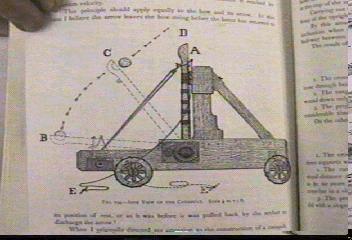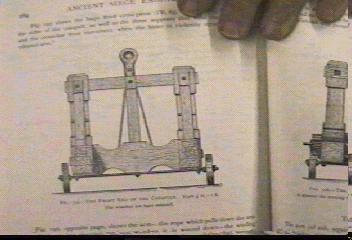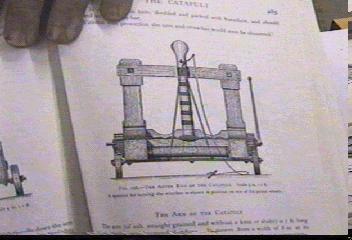Kaz and Lina's Onager
(Francis)
A second in our documentaries of SCA combat siege
weapon
construction. This onager is designed as a companion piece to the
Bird of Prey, our combat ballista. It is a torsion engine,
powered
by a cord skein. It has a period cocking mechanism and can be
tensioned
strong enough to throw actual payload as well as combat 'rocks'
The same primary considerations applied as when we
chose
a design for the Bird of Prey. Mobility was not as important as
cost,
durability, transportability and appearance. So with these things
in mind, we decided on a scale of slightly larger than 1:2 for
the
engine (compared to the engine dimensioned in The Crossbow). This
would allow the frame to fit in my van with only minor disassembly, and
still would give it enough size to be an effective power source.
The frame ended up around 6 foot long and 4 foot wide.
We chose to make the engine out of treated lumber,
stock
4x4 and 4x6 sizes were used throughout. The treated lumber was
used
because we knew that we would be storing the engine outdoors quite a
bit
(like the Bird), and with a good stain it is both weather and parasite
resistant.

Here is a picture of the finished engine - it is
quite
impressive. It works well with both 1 pound combat rocks and 4
tennis-ball
clusters, as well as doing an impressive job throwing water-filled
plastic
milk jugs for static (non-combat) demonstration

The materials needed to build the frame of the
Onager.
These are 4 x treated landscape timbers. You will need 3 - 12
foot
4 x 6 and 1 - 8 foot 4 x 4.

A side view of the onager built by Sir Ralph
Payne-Gallwey.
This engine is well represented in his book "The Crossbow", these
drawings
are from that book. The Onager as shown measures 10 foot 6 inch
in
length. We scaled our engine to fit in our van - it is 6 foot
long.

A front view of the onager - the original was 6
foot
between the rails, our engine is 4 foot outside dimension.

Rear view of the engine - the original was
constructed
of 12 x 18 timbers for the side rails and the front brace, and the
uprights.
The rest was no smaller than 6 x 6, and the winch roller was 7 inch in
diameter.


